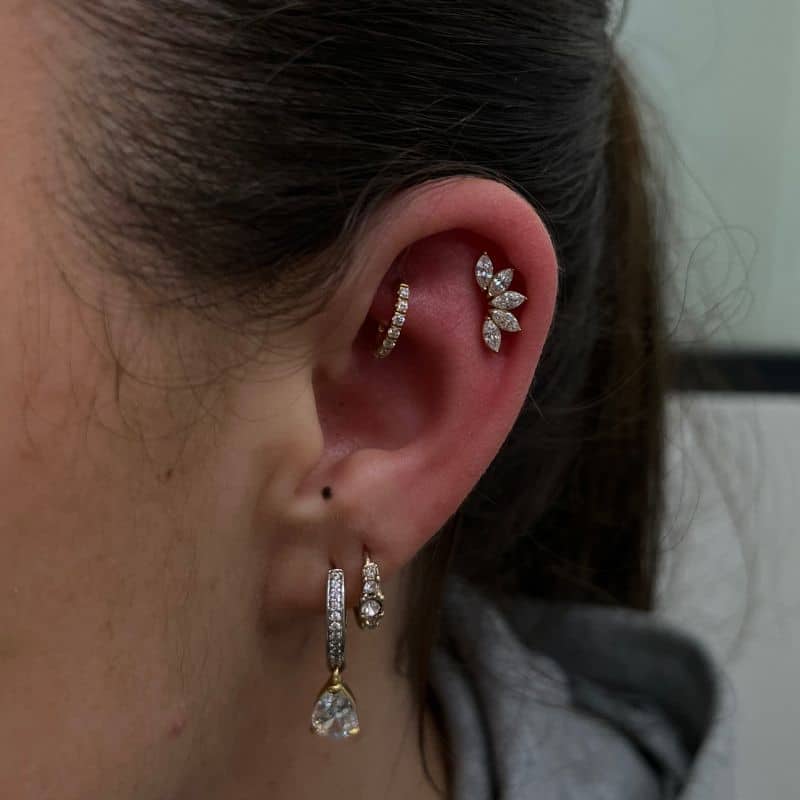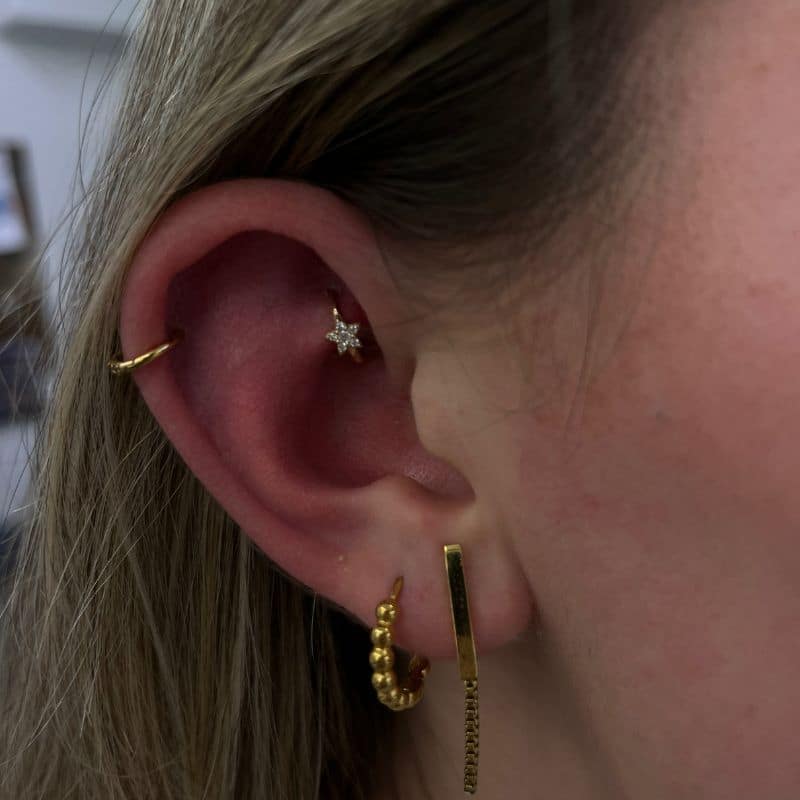Introduction to helix piercing
Placement:
A helix piercing is pierced at the upper edge of the ear, which is called the helix. The tissue at this point consists of cartilage, which heals more slowly compared to the earlobe due to the thin skin and reduced blood circulation. There are various locations on the helix and the pinna where a piercing can also be pierced, the most common of which are:
- Forward Helix: On the upper, inner ear arch, near the temple. Goes right through the cartilage arch.
- Mid Helix: In the middle of the outer ear arch, can be stitched as high or low as desired
- Vertical HelixVertically through the outer helix curve of the ear so that both sides of the jewelry are visible from the front.
- Industrial: Two piercings connected by a straight bar, one on the upper inner and one on the lower outer edge of the helix.
- Flat: On the flat surface of the helix
- Vertical helix:is pierced vertically through the outer tissue at the upper edge of the ear, which is called the helix, so that both sides of the jewelry remain visible from the front

Helix piercing styles
Gallery of helix piercings
All about helix piercings
Helix piercings: Everything you need to know
History:
Helix piercings, also known as cartilage piercings, have been around for centuries. They have been worn in many cultures for aesthetic and spiritual reasons. In the western world, helix piercings became popular in the 1980s and have been a popular jewelry trend ever since.
Placement:
A helix piercing is pierced at the upper edge of the ear, which is called the helix. The tissue at this point consists of cartilage, which heals more slowly compared to the earlobe due to the thin skin and reduced blood circulation. There are various locations on the helix and the pinna where a piercing can also be pierced, the most common of which are:
- Forward Helix: On the upper, inner ear arch, near the temple. Goes right through the cartilage arch.
- Mid Helix: In the middle of the outer ear arch, can be stitched as high or low as desired
- Vertical HelixVertically through the outer helix curve of the ear so that both sides of the jewelry are visible from the front.
- Industrial: Two piercings connected by a straight bar, one on the upper inner and one on the lower outer edge of the helix
- Flat: On the flat surface of the helix
Jewelry:
For helix piercings, a labret with a bar thickness of 1.2mm is used for vertical helix, a barbell for vertical helix and either a barbell or labret for forward helix. Many different types of jewelry are suitable after healing, particularly popular are:
- Labrets: Plug with ball or decoration at the front and flat back
- BarbellsBars with balls at both ends, or with a decoration at the front, preferably for vertical helix piercings.
- CBRs (Captive Bead Rings) / BCRs: Rings with a ball that is inserted into the ring
- Clicker / click segment rings: Rings with decorations such as cubic zirconia, Swarovski, patterns, snakes, etc.
- CBBs (Circular Barbells): Horseshoe-shaped rings in various sizes and designs with balls or points on both sides.
- InternalInternally threaded jewelry with decoration, shapes, patterns etc.
Healing time:
The healing time of a helix piercing can vary, but is usually between 3 and 6 months. Cartilage tissue generally heals more slowly than the softer tissue in the earlobe. It is important to be patient during the healing phase and to follow the care instructions carefully.
Dangers and complications:
As with any piercing, there is a risk of infection, allergic reactions and scarring with a helix piercing. It is important to be pierced by a professional piercer and to use high-quality jewelry to minimize these risks.
Recommendations for care:
- Disinfect the piercing 3-5 times a day with a suitable piercing spray. We recommend the use of our Piercing Care. We have achieved the best results with this piercing spray over the years.
- Avoid touching or pulling on the piercing. Please do not use Q-tips (cotton buds) for cleaning and use a clean handkerchief for crusts.
- Sleep on the other side of the head until the piercing has healed. Otherwise the piercing may become crooked and cause problems.
- Do not wear headphones or earplugs until the piercing has completely healed.
- Make sure that your hair does not touch the piercing if possible.
- If you are unsure about swelling, redness or pain, come and see us.
Additional information:
- Pain: The piercing of a helix piercing is usually associated with a short, sharp pain. Most people experience the pain as moderate. However, the sensation of pain varies from person to person.
- Costs: The cost of a helix piercing varies depending on the jewelry. Our prices start at CHF 65 including standard jewelry.
- Jewelry change: Once the piercing has healed completely, you can change the jewelry. However, it is important to use high-quality jewelry to avoid infection.
Conclusion:
Helix piercings are a popular way of expressing your own style. They are relatively painless and heal well if cared for properly. If you are considering a helix piercing, you can drop by one of our branches at any time, we always pierce spontaneously and are happy to advise you without an appointment.
Are you ready for your helix piercing?
Our experienced team at Stechwerk is here to provide you with a safe and professional piercing experience. Contact us now if you have any questions.


